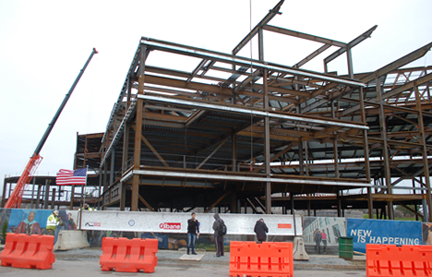May 2, 2014

UMass Boston's GAB No. 1, which is next to the Campus Center, will support the university’s growing student enrollment and course offerings. It will house three academic programs: Art, Chemistry, and Performing Arts. Photo courtesy UMB
A milestone in UMass Boston's latest building project was celebrated with a traditional Topping Off ceremony on the Dorchester campus on Wed., April 30. The installation of a decorated I-beam was pushed off until better weather on Friday, but officials were on hand to admire the work to date at General Academic Building Number One (GAB1) — a $113 million, 181,000 square foot, four-story structure.
Funding for the GAB1 is managed by the UMass Building Authority, which is also responsible for hiring the architects, contractors and subcontractors. The main contractor is Gilbane Building Co. Joe Gallagher, Vice President of District Manager of Business Development at Gilbane, spoke about the significance of the event.
“In a Topping Off, we honor the trade people for their quality construction. We honor the ancient tradition of placing the symbolic tree (thought to mean several things most commonly interpreted as a symbol that the work was completed safely and as a wish of luck to the future inhabitants) on the beam. We honor our country by placing the American flag on the beam,” Gallagher said.
Ironworkers from Local 7 and members of the community were invited to sign the symbolic and structurally supportive beam. Several students decorated the beam with their names, graduation years, and well wishes for future students. Senator Linda Dorcena Forry and City Councilor Frank Baker signed the beam as well.
Workers were not able to install the beam on the 30th due to inclement weather, but it was installed on Friday, May 2.
After signing the beam, Chair of the UMass Building Authority Phillip Johnston addressed concerns that the growth of the campus would result in a higher price tag for current or future students.
“This (the $113 million) is capital money and it is already appropriated,” said Johnston. “Between the state and the building authority we have about $6 billion to spend on the 5 campuses. We are hoping we will get a $50 million boost from the legislature this year as we did last year.” “If we get that then there won’t be any increase in fee’s. That is the commitment we made to the governor and the legislator, and so far so good,” Johnston added. “Our objective is to have first class quality education and be affordable to as many students as possible in Massachusetts. I am an alumni myself from UMass Amherst and I would have found it difficult to afford college had it been at a high cost institution.”
State Senate President Therese Murray, a UMass Boston graduate, also attended the topping-ff event. When asked about the changes that have taken place since her graduation Murray responded, “There is no comparison. These new buildings have made the campus a world class attraction, particularly in science and technology.”
The building— which looks out onto Morrissey Boulevard and Dorchester Bay— is one of several construction projects currently underway on the Dorchester campus. The construction of the Integrated Science Complex, GAB1, the Edward M Kennedy Institute, and rearranging of the roadway are all parts of UMass Boston’s 25 year plan to become a high research model institution. These buildings are the first of many projects to come like GAB2 and 3 as well as the eventual construction of dormitories.
Boston City Councilor Ayanna Pressley tweeted out praise for the developers who worked on the Integrated Science Complex (ISC) for meeting the Boston Residents Jobs Policy (BRJP). The ordinance asks developers to create a workforce that is at least 50 percent Boston residents, 25 percent minority and 10 percent women. Walsh Building Co. is constructing the ISC.
The GAB1 has workforce requirements identical to the BRJP under a project land agreement signed by the UMass Building Authority. Currently Gilbane is short of the workforce requirements. To date, 33 percent of the workforce on GAB1 are Boston residents, 22 percent are minority and 5 percent are women.
Susan Moir, Director of the Labor Resource Center at UMass Boston, explained the difficulty involved in meeting the workforce requirements.
“We have a supply problem," said Moir. "Right now we have nearly full employment of tradeswomen in Boston. In addition there are historic and structural barriers to women who want to work, particularly in early phase construction areas like ironworkers.
"Gilbane is firmly committed to meeting the standards. We fully expect them too by the end and no one who is working on this now is satisfied that they have not already.”
GAB1 will house the Art and Chemistry departments, a 500 seat lecture hall, a 220 seat lecture halls a 200 seat theater and 150 seat recital hall. It is expected to be completed in the fall of 2015.
Villages:
Topics:


